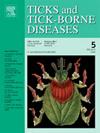Expression patterns of chemokine mediators and TLR10 in natural bovine babesiosis and anaplasmosis infections
IF 3.4
2区 医学
Q2 INFECTIOUS DISEASES
引用次数: 0
Abstract
Cattle tick fever, caused by the protozoa Babesia bovis and B. bigemina and the rickettsial bacterium Anaplasma marginale, represents a significant constraint to livestock productivity worldwide. Taurine cattle are considered more susceptible to these hemoparasites than zebuine breeds. Chemokines and Toll-like Receptors (TLRs) play key roles in immune processes such as chemotaxis and inflammation, primarily through interactions with respective receptors. This study assessed the relationship between the expression of four chemokine-related genes (ccr3, cxcl12, cxcl8, and cxcr1) and one TLR (tlr10) with the infection levels of B. bovis, B. bigemina, and A. marginale in 24 naturally infected calves from two genetic groups (Angus [n = 13; 100% taurine] and Ultrablack [n = 11; 82% Angus, 18% zebuine]). Blood samples were collected every 30 days over six time points (Nov 2021–Apr 2022). DNA was used to quantify hemoparasite loads by qPCR (log DNA copy number, CNlog), while RNA was used for RT-qPCR-based gene expression analysis. A mixed model was used to assess associations between gene expression and infection levels, controlling for evaluation, sex, genetic group, and their interactions. All genes, except cxcl12, showed significant associations with at least one hemoparasite. Higher B. bovis and B. bigemina CNlog values were linked to reduced expression of most genes, whereas A. marginale infection was associated with increased gene expression. These findings highlight distinct immune modulation strategies by hemoparasites and underscore the need for species-specific interventions. Further studies are required to explore the mechanisms by which these mediators influence susceptibility or resistance in cattle.
趋化因子介质和TLR10在天然牛巴贝斯虫病和无形体病感染中的表达模式
牛蜱热是由牛巴贝斯虫和双头贝斯虫原生动物以及立克次体无原体边缘细菌引起的,是世界范围内牲畜生产力的一个重大制约因素。牛磺酸牛被认为比zebuine品种更容易感染这些血液寄生虫。趋化因子和toll样受体(TLRs)主要通过与各自受体的相互作用,在趋化和炎症等免疫过程中发挥关键作用。本研究评估了来自两个遗传群体(安格斯[n = 13; 100%牛乳]和超黑[n = 11; 82%安格斯,18% zebuine])的24头自然感染小牛的4个趋化因子相关基因(ccr3、cxcl12、cxcl8和cxcr1)和1个TLR (tlr10)的表达与牛双头牛双头牛和边缘化牛双头牛感染水平的关系。在6个时间点(2021年11月- 2022年4月)每30天采集一次血样。采用DNA qPCR (log DNA拷贝数,CNlog)定量血寄生虫负荷,采用RNA rt -qPCR进行基因表达分析。混合模型用于评估基因表达与感染水平之间的关系,控制评估、性别、遗传群体及其相互作用。除excl12外,所有基因均与至少一种血液寄生虫有显著关联。较高的B. bovis和B. bigemina CNlog值与大多数基因表达降低有关,而A. marginale感染与基因表达增加有关。这些发现强调了血液寄生虫独特的免疫调节策略,并强调了物种特异性干预的必要性。需要进一步的研究来探索这些介质影响牛的易感性或抗性的机制。
本文章由计算机程序翻译,如有差异,请以英文原文为准。
求助全文
约1分钟内获得全文
求助全文
来源期刊

Ticks and Tick-borne Diseases
INFECTIOUS DISEASES-MICROBIOLOGY
CiteScore
6.90
自引率
12.50%
发文量
185
审稿时长
6-12 weeks
期刊介绍:
Ticks and Tick-borne Diseases is an international, peer-reviewed scientific journal. It publishes original research papers, short communications, state-of-the-art mini-reviews, letters to the editor, clinical-case studies, announcements of pertinent international meetings, and editorials.
The journal covers a broad spectrum and brings together various disciplines, for example, zoology, microbiology, molecular biology, genetics, mathematical modelling, veterinary and human medicine. Multidisciplinary approaches and the use of conventional and novel methods/methodologies (in the field and in the laboratory) are crucial for deeper understanding of the natural processes and human behaviour/activities that result in human or animal diseases and in economic effects of ticks and tick-borne pathogens. Such understanding is essential for management of tick populations and tick-borne diseases in an effective and environmentally acceptable manner.
 求助内容:
求助内容: 应助结果提醒方式:
应助结果提醒方式:


